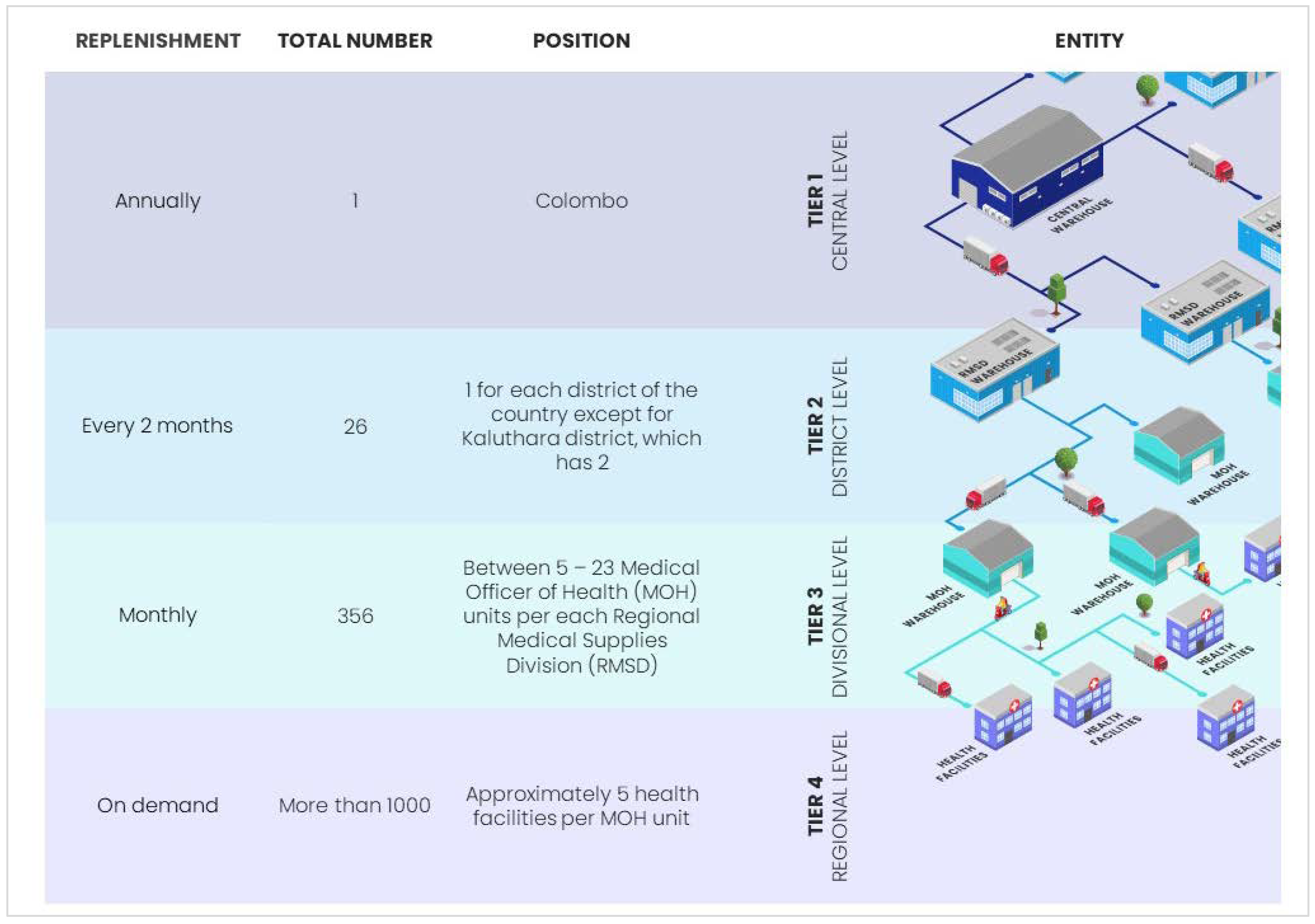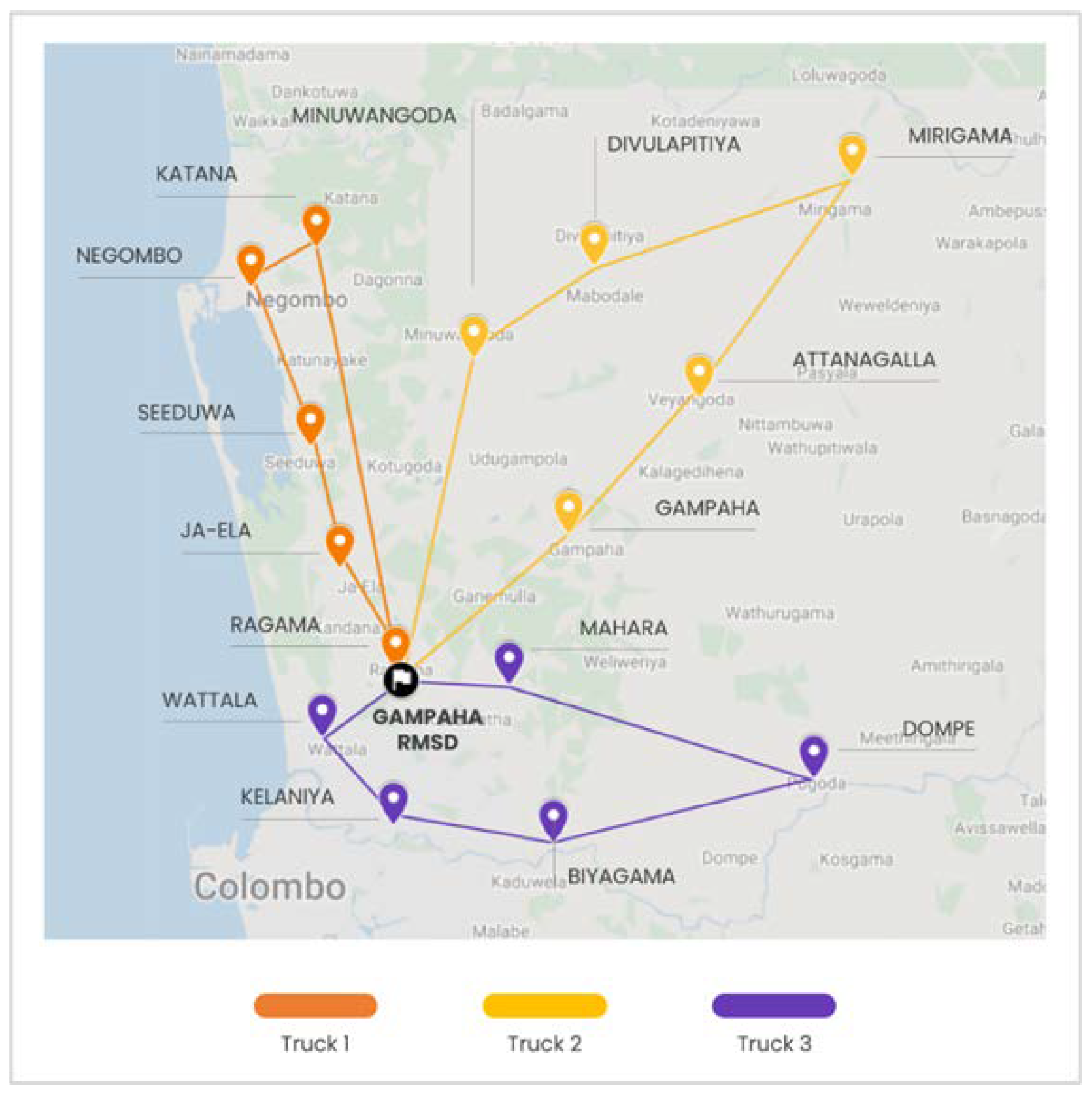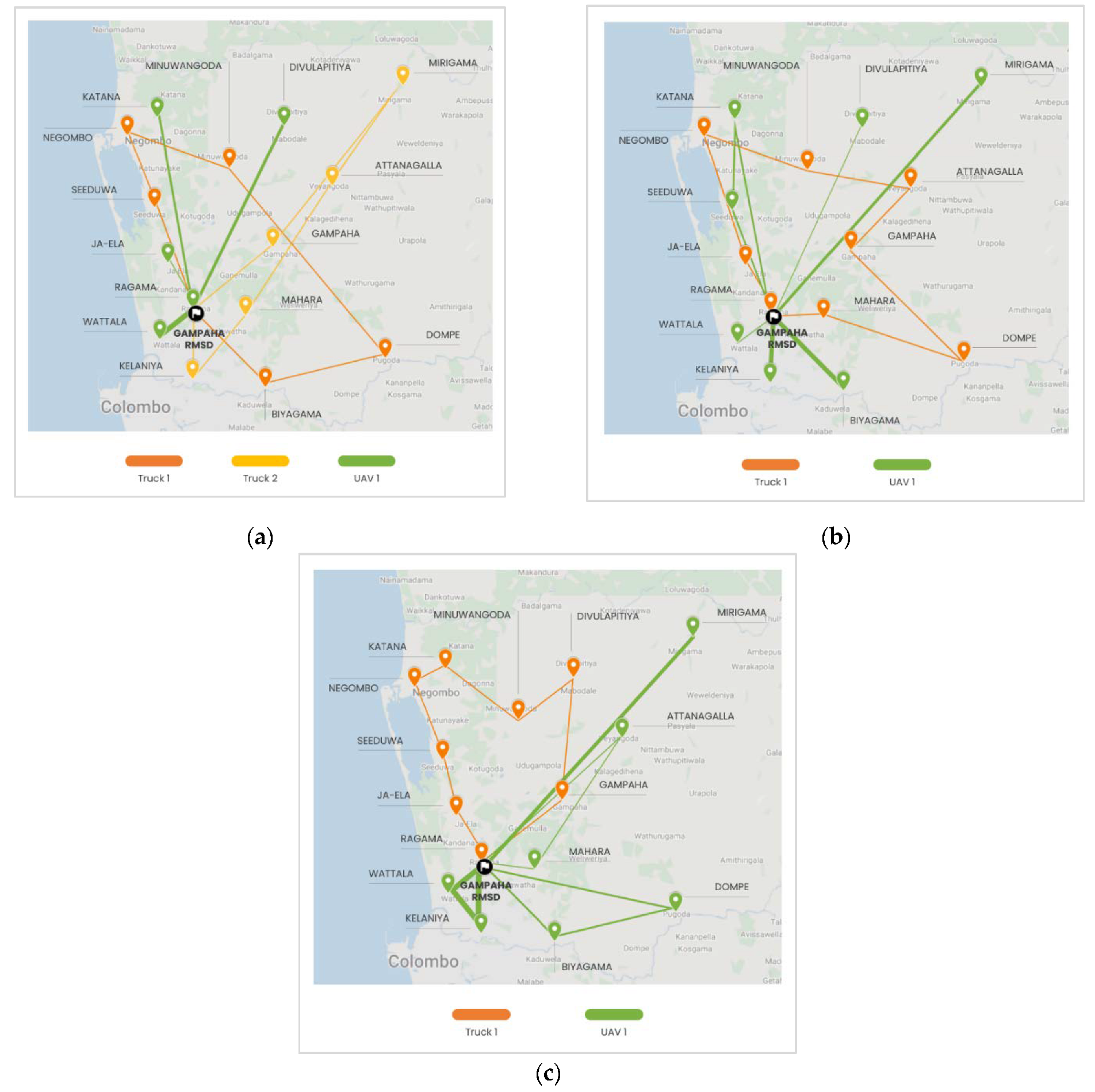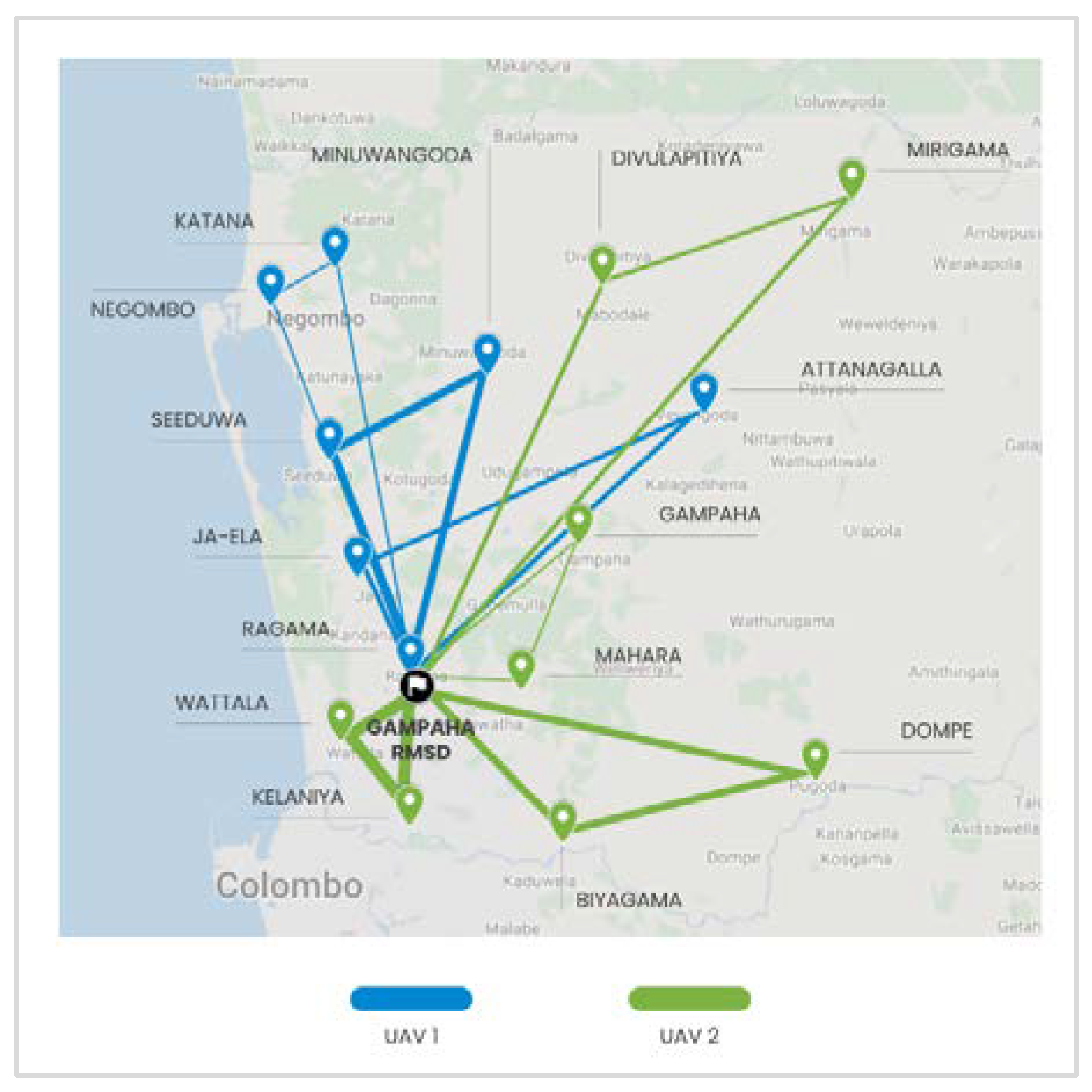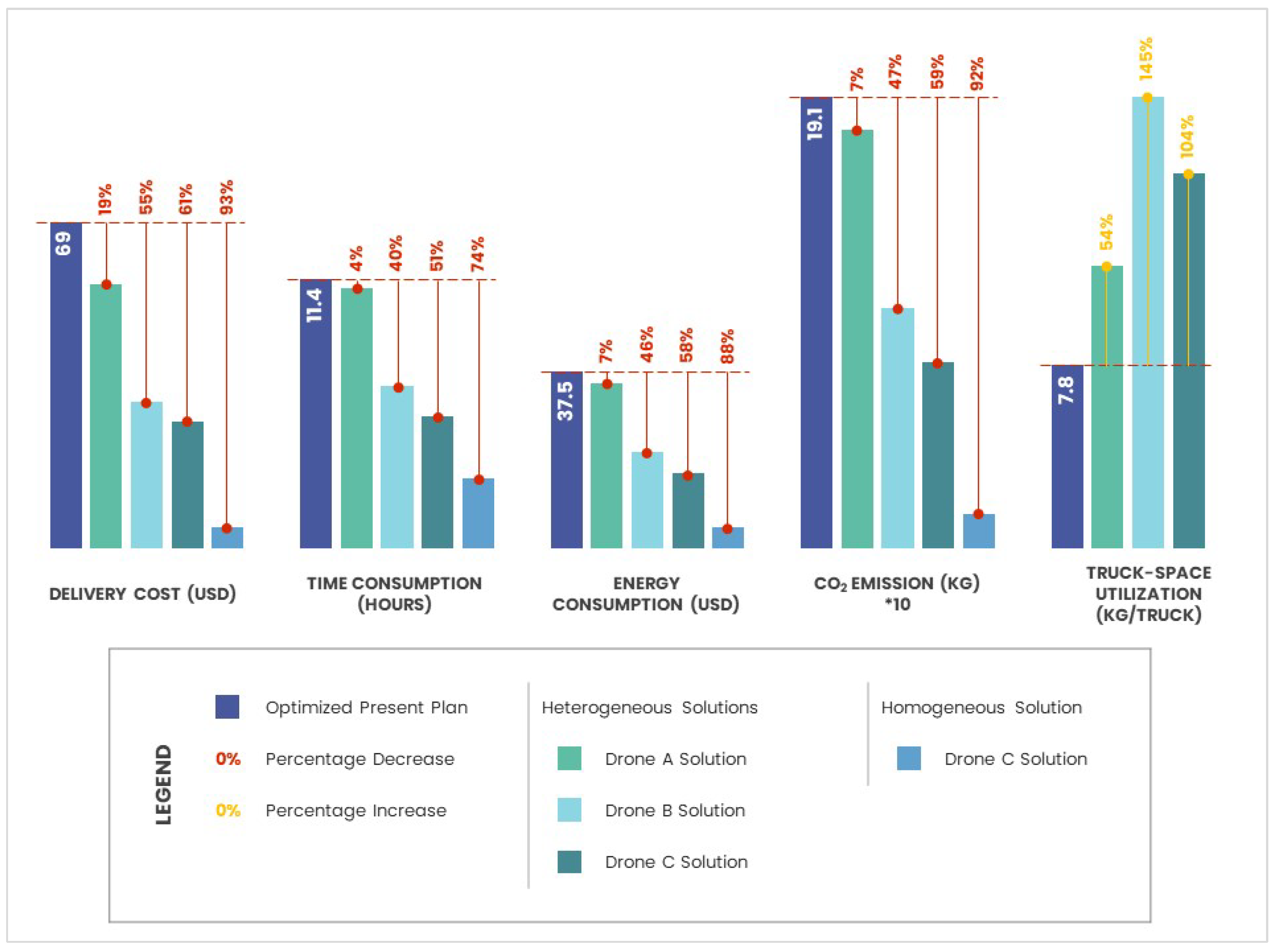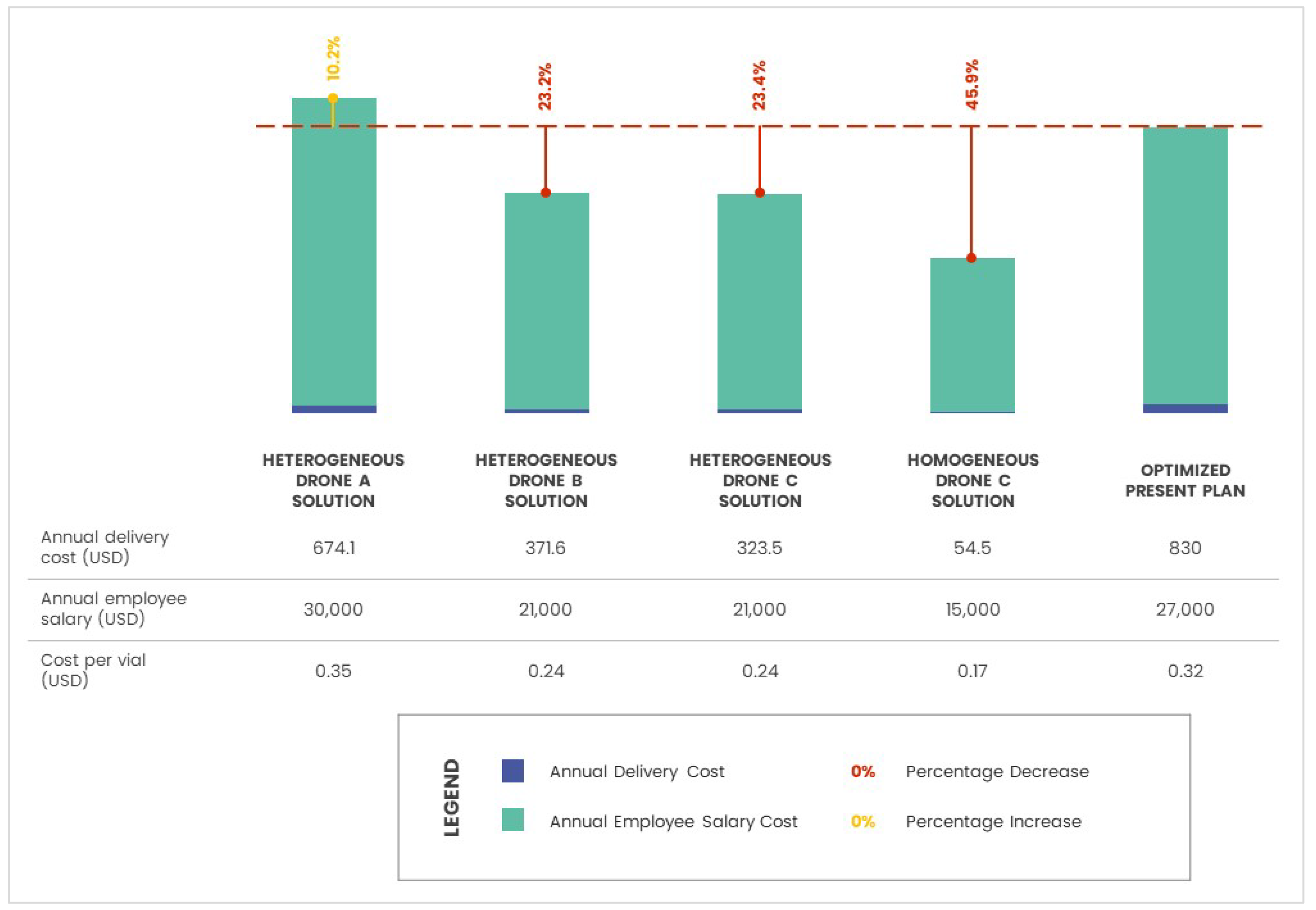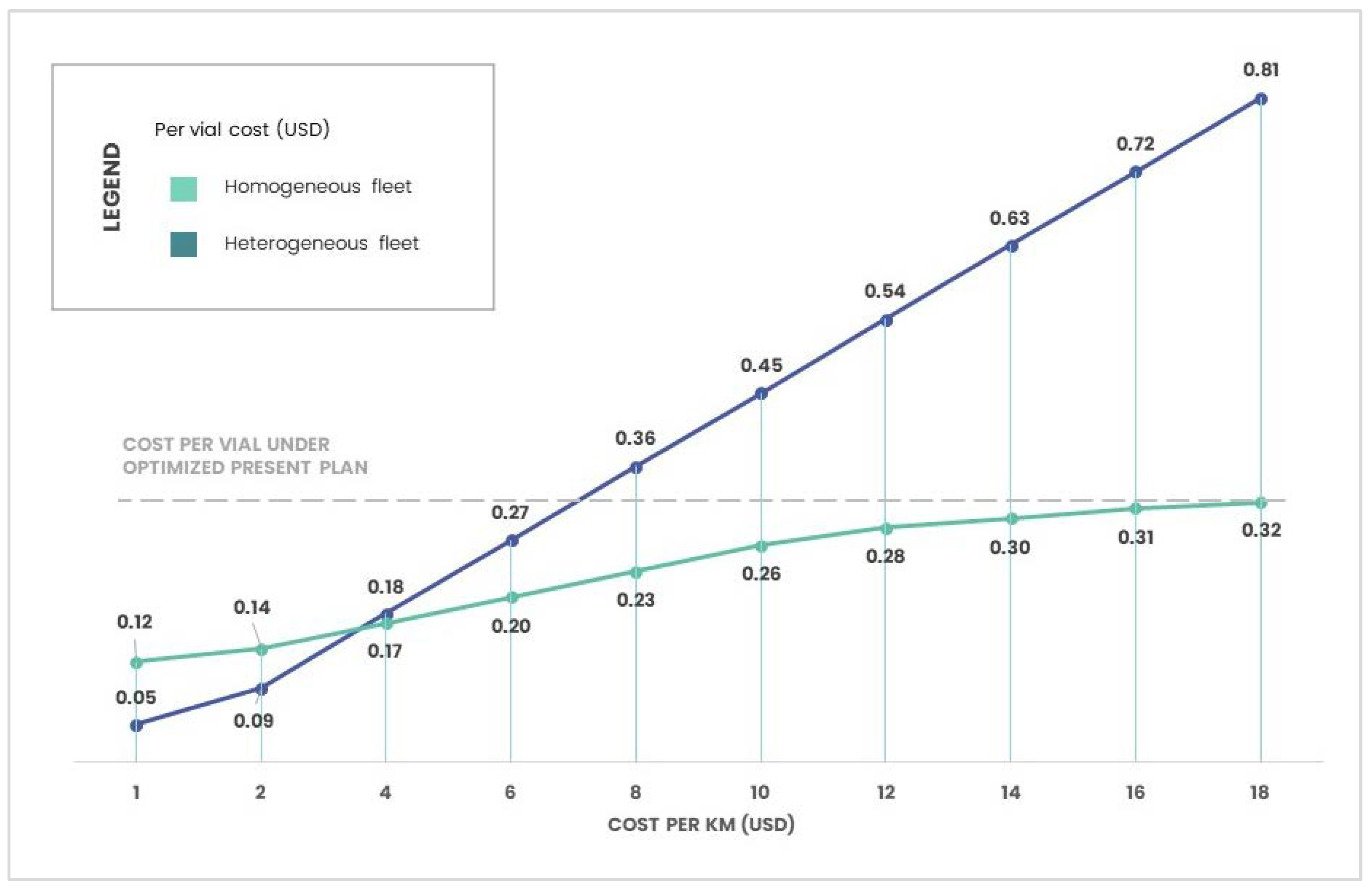1. Introduction
A well-functioning supply chain is one of the main enablers of a successful healthcare system [
1] because without a good logistics network, the timely availability of quality and affordable healthcare products cannot be assured [
2]. However, public health service providers in low-income countries have failed to recognize its importance [
1]. The distribution model, where the government purchases medicines and vaccines and delivers them using government-owned transport fleets, is a recurring theme in many low-income countries [
1]. Most of these nations have been practicing this same system for decades with little-to-no investments and studies toward improvements. As a result, their logistics networks have remained weak and ineffective, threatening the longevity and responsiveness of healthcare programs [
3,
4]. Therefore, it is high time to analyze potential solutions to uplift the healthcare logistics in low-income countries.
Since the invention of UAVs, they have been effective in being a way out of the physical and economical impediments in delivery networks [
5,
6]. In fact, UAVs have proven capabilities of successfully delivering small weights whilst ensuring reduced financial, environmental, and social impact [
7,
8,
9]. Hence, over the years, more and more studies and pilot projects have been undertaken on the utilization of UAVs to improve healthcare availability and logistics systems [
5,
6,
7]. Therefore, recognizing the capabilities of UAVs, this research aims to identify whether UAVs are a successful investment for low-income countries to uplift their healthcare industry.
Accordingly, the study analyzes the economic, environmental, and capital aspects of incorporating UAVs in a healthcare supply chain of a low-income country. Through the results, the study aims to identify the benefits of investing in drones and the ideal fleet composition and execution plan for the initial implementation. We aim to act as a decision-support tool aiding in further studies on the utilization of drones in improving efficiency in healthcare logistics of low-income countries. Moreover, we hope to encourage low-income countries to study novel technological applications that can assist in improving the local service sector.
The study identifies the existing land-based delivery system and UAV solutions through expert interviews and route optimization techniques, respectively. Then, through a comparative analysis of KPIs calculated amongst the actual and futuristic situation, it is identified whether improvements can be expected by using UAVs in a low-income country. As a case study to analyze the effects, the Sri Lankan vaccine supply chain was selected. Because it is reminiscent of many other developing countries, Sri Lanka has continued to execute conventional delivery systems with little to no technological advancements over the years. Moreover, the continuous expansion of the vaccine program and increasing financial burden have been threatening the program’s longevity.
2. Literature Study
The following section elaborates on the study of previous literature about drone use in healthcare logistics. The segment recognizes the research gaps and suitability of UAVs for this study.
Drones in the Healthcare Logistics
A UAV is an aircraft controlled distantly via radio waves or autonomously without any aircrew on board [
5]. The continuous technological growth has resulted in increased levels of autonomy in UAVs. This has also enabled automated take-off, landing, obstacle evasion, and course planning [
8]. Additionally, its low maintenance cost, driverless mobility, and absence of road network dependency have made the vehicle cost-effective compared to conventional aircraft and increased its applications in civil domains [
9].
Among the many public use cases of UAVs in delivery, its placement in the healthcare field is one of the most promising applications. Previous studies have assured that drones can improve coverage by delivering products to otherwise unreachable locations such as islands, swamps, or deserts [
10]. According to HERMES generated simulation model by the workings of Haidari et al. [
7], usage of UAVs could increase vaccine availability from 94% to 96% in Gaza province, Mozambique. Furthermore, a pilot project in Madagascar successfully delivered drugs and laboratory samples to remote areas by avoiding difficult terrains [
11]. However, it is worth noticing that the main objective of these studies or projects was to improve healthcare availability and reach better healthcare coverage within a country. Considering the specialties and capabilities of drones, improving accessibility to health is the most apparent application. However, studies have also identified that UAVs can reduce delivery inefficiencies as well [
12].
Despite the good infrastructure and considerable healthcare coverage, drones can further aid the healthcare field by increasing efficiency and reducing operational costs [
13]. The works by Zubin et al. [
12] identified that the use of drones replacing one of three delivery trucks in the supply of pharmaceutical products to customers in Rotterdam could reduce the annual logistic cost, time consumption, and carbon dioxide emission by 12.5%, 12%, and 9%, respectively. Furthermore, the ability to transverse difficult terrains, reduced labor costs, and replaced large vehicle fleets assist in logistics cost reductions [
14,
15]. Despite such possibilities, most studies have focused on improving healthcare coverage using drones, with very few focusing on their ability to reduce logistics inefficiencies in traditional healthcare delivery networks. Hence low-income countries, which often face financial uncertainties and delayed deliveries due to poorly functioning transport systems, could be aided by UAVs [
1,
16].
3. Background Study
The upcoming subtopic explains the established vaccine distribution network in Sri Lanka. Moreover, the main issues in the current logistics network and delivery that are suitable for the UAV application are addressed in the content.
Sri Lankan Vaccine Distribution Network
The Expanded Program on Immunization (EPI) is currently the Sri Lankan National Immunization Program’s (NIP) fundamental component [
17]. The Epidemiology Unit is responsible for executing and monitoring the EPI vaccine cold chain within Sri Lanka [
17]. They ensure the availability of EPI vaccines at every maternal and child health (MCH) clinic and hospital all year round. To facilitate the regular countrywide supply, the vaccine distribution system adheres to an established healthcare administrative system comprised of four tiers [
17,
18].
Figure 1 shows the entities and delivery arcs under the said four levels when the EPI cold chain is concerned [
17,
18].
This distribution system has successfully ensured the reachability of EPI vaccination services to the smallest social units of the country. However, the explicit, complex, and widespread nature of the system has resulted in major cost accumulations, wastage, and time consumption. Like many other low-income countries, the complete reliance on the road network and the persisting issues in the cold chain are the primary sources of such inefficiencies [
1,
19].
Currently, the complete vaccine supply chain relies on the local road network and government-owned vehicle fleets. However, the poor-quality roads, difficult terrains, and hindrances during monsoon seasons have been threatening the maintenance of a reliable distribution network [
19,
20,
21]. Moreover, the lack of standard cold chain equipment (CCE) for delivery in the district and divisional levels is a further root cause of the logistics issues in the local cold chain [
17,
18,
19]. Considering the substantial financial burden upon the government to continuously provide free health services, reducing these inefficiencies will aid immensely. Hence, it is appropriate to identify potential methods to diminish these problems that will ensure a solid and sustainable EPI program in Sri Lanka.
Among the three delivery arcs, the most suitable delivery arc for drone implementation is the district level because, while being a heavy cost accumulator, it is also the delivery arc that must maintain a routine delivery schedule regardless of the poor transport infrastructure. Conversely, the central level utilizes standard infrastructure, while the stochastic delivery at the divisional level might not support the optimum utilization of the drone. Therefore, the following sections of the study elaborate on the effect of incorporating UAVs in the district-level vaccine distribution in Sri Lanka.
4. Methodology
The objective of the study is to identify whether UAVs are a suitable investment for low-income countries to uplift their healthcare logistics networks. To achieve the said objective, a comparative analysis was conducted. A comparative analysis is a technique of comparing two or more subjects to identify differences or similarities among them [
22]. In this study, key performance indicators (KPIs) were calculated and compared between a current distribution plan and plausible alternative UAV solutions for a Regional Medical Supplies Division (RMSD) [
12]. The following four sections display the steps followed in conducting the comparative analysis.
4.1. Identifying the KPIs
To identify whether UAVs are a suitable and sustainable investment, it is vital to analyze the economic, environmental, and capital aspects [
5]. Due to the substantial effect of the capital aspect of UAS, the three areas were analyzed under two time frames, as mentioned in the following sections. To quantify the aspects under the two time frames, KPIs identified from previous literature were used [
12,
13].
4.1.1. Short Term
The focus of the short-term period is to analyze the operational and environmental aspects of investing in UAVs, neglecting the capital impact. Therefore, this time frame focused on factors in one delivery round.
Table 1 shows the KPIs considered to quantify the aspects considered in this section.
4.1.2. Long-Term
The long-term time frame financially analyzes the capital aspect of investing in drones. A UAS incurs a considerable capital cost compared to a traditional road delivery system [
5]. The reason is due to the expensive UAV technology and infrastructure. Hence, recognizing the capital aspect of the solution is vital to provide an overall view of UAS implementation, especially in low-income countries.
Therefore, human resource, UAS, and operational costs the government must bear within the first year if invested in drone technology were analyzed for the long-term time frame. When considering the UAS cost, there are three possible ways of receiving UAS services for a low-income country. One way is establishing a UAS setup through funds from international donors and conducting the operations from government finances. In the health industry, allocating such funds to low-income countries is prominently seen [
13]. The second possible method is the local government financing the initial UAS setup cost and operational expenses, and the final method is outsourcing UAS services. Unlike the previous two methods, in this situation, the country does not hold ownership of the UAS. Instead, the UAS service is provided by a third party, who will be paid an agreed constant amount per km [
13]. Accordingly, as mentioned in
Table 2. the cost per vaccine vial under the three possible financing methods was analyzed to replicate the capital aspect of the investment.
4.2. Identifying the Present Delivery Plan
The next step is to determine the land-based delivery plan that is currently utilized at the district level. Field visits to the epidemiology unit and the selected RMSD along with face-to-face interviews with epidemiologists and public pharmacists were used to collect information.
4.3. Identifying the UAV Solutions
The follow-up step is to identify potential UAV solutions that can be used as an alternative to the existing delivery plan. UAVs can be utilized as a homogeneous fleet (only UAVs) or as a heterogeneous fleet (both trucks and UAVs) for distribution. To provide a general outlook on UAV solutions, both fleet types are considered separately in the analysis.
Accordingly, there are many route optimization techniques in the literature that can be used to derive UAV solutions [
23,
24,
25]. Within these techniques, the UAV is used in different ways when working in parallel with another mode. As an example, UAVs could be routed independently or dependent on the truck, contingent on the routing technique. In this use case, the destinations are reachable by trucks; hence, the drone must work independently and simultaneously with the truck, allocating a set of destination nodes per vehicle. Therefore, among the many techniques, parallel drone scheduling vehicle routing problem (PDSVRP) is included [
26,
27].
PDSVRP is a subsidiary formulation of the parallel drone scheduling traveling salesman problem (PDSTSP) formulated by Murray and Chu [
28]. This technique could optimize the route based on the objective of reducing cost, time, or distance. In this study, the primary focus was to reduce the overall logistics cost in healthcare supply chains of low-income countries. To solve the PDSVRP and obtain the UAV delivery solutions, the open-source vehicle routing problem (VRP) spreadsheet solver by Dr. Erdoǧan [
29] was used. Other promising formulations and solution approaches of exact, heuristic, or meta-heuristic character could also have been investigated [
30,
31,
32].
Open-Source VRP Spreadsheet Solver by Dr. Erdoǧan
The VRP spreadsheet solver uses a metaheuristic algorithm coded through visual basics to deliver the optimized route outputs [
29]. The objective of the solver is to generate a sequence of nodes that produce the least cost under the provided constraints [
29]. Hence, it is ideal for this study. Furthermore, it has been used in several pieces of literature to solve VRP due to its convenience and leniency in understanding. In fact, works by Karthik et al. [
33] mentioned that this VRP spreadsheet was able to derive better results than the Clark and Wright savings algorithm. Furthermore, according to the works by M.B. Roddanavar et al. [
34], the solver provides realistic and pragmatic solutions. The solver is designed to be able to solve any VRP with any mode of the vehicle. It accommodates bird flight distance computation to allow applications with UAVs or airplanes. However, since the solver only allows one method of distance computation to be used at once, the truck distance parameters are calculated using a suitable duration multiplier. The solver’s inputs are vehicle parameters, locations, demands, distance computational method, and variable and fixed cost of the vehicle, and the solver generates a solution with the least cost. The solution also includes the optimal fleet allocation and the destination sequence.
4.4. Comparative Analysis
In the final step, the KPIs identified in
Section 4.1 were calculated and compared between the present delivery plan and the solver-derived UAV solutions. This enables us to quantitatively identify the changes that may happen in healthcare logistics by investing in drones [
12].
5. Data Collection
The following segments elaborate on the data collected and the collection process under each step of the analyzing methodology.
5.1. Current Delivery Plan
Due to the decentralized administration of the healthcare system, each RMSD follows its vaccine distribution plan. However, for reasons of comparison, it is vital to collect data from an RMSD that practice a systematic and routine distribution system. According to expert interviews among the twenty-six RMSDs in Sri Lanka, the division that currently practices such a distribution plan is Gampaha RMSD. Hence, it was selected as the data collection ground for this research.
Figure 2 displays the existing delivery plan at the Gampaha RMSD along with the average monthly demand of the Medical Officer of Health (MOH) units under its authority.
The average monthly demand of the MOH units was collected for 2019 because, in the following few years, the monthly demand reduced drastically due to COVID-19. Therefore, it does not represent the usual vaccine flow between the RMSD and the respective MOH units. Nevertheless, as apparent from the figure, the distribution of the fifteen MOH units is currently completed with four truck trips on four separate days. However, according to the expert interview, the above-mentioned existing delivery plan does not utilize optimized routes. Since the solver-produced delivery plans are optimized, if compared with the actual existing delivery plan, an inaccurate interpretation of the benefits is derived. The first rule to determine whether a UAV solution attracts advantages over an existing delivery network is to check if the UAS offers advantages over well-managed land transport and not only the present circumstances [
5]. Therefore, to produce accurate results, an optimized delivery plan for the present situation was derived using the same spreadsheet solver. This enables us to compare the UAV delivery solutions with the optimized present delivery plan. Hence, the validity of the benefits that can be yielded from UAVs is assured.
Table 3 shows the data descriptions used to determine the optimized present delivery plan (sensitive data omitted).
5.2. UAV Solutions
It is crucial to identify a drone with suitable qualities for the applied use case to produce a positive outcome [
5,
6]. In this use case, UAVs transport vaccine vials between already existing health facilities. Therefore, it is crucial to be mindful of the space required for the UAV to function. Furthermore, to attract environmental benefits, it is recommended to use electric-powered or hydrogen-powered drones instead of fuel-powered drones. Considering these requirements, it was suggested to utilize small, electric-powered or hydrogen-powered, vertical takeoff and landing (VTOL) UAVs [
5]. Additionally, since the study addresses international donor support for the UAS setup, it was essential to identify UAS providers who have existing relationships with international donors. Considering those parameters, three existing UAV providers in the industry were considered in this research. However, the names of the three service providers are not revealed due to confidentiality reasons. Instead, depictive names are used throughout the analysis.
Table 4 displays the three UAV providers along with the characteristics of their UAVs [
10,
35].
The
Table 5 below displays the cost components that were considered to calculate the short-term and long-term KPIs for UAVs.
The drone’s performance is influenced based on its range, speed, payload, and service time parameters [
33,
34,
35]. The electricity consumption of the drone was calculated according to the findings from Dündar et al. [
36]. The study identified the energy use of a small, fixed-wing VTOL drone that is traveling at 72 km/h speed with a 0.4 kg payload through a simulation. Using the same findings, the respective energy consumption of the three drones that were used in this study was calculated.
Accordingly, the data descriptions in
Table 6 were identified (sensitive data omitted). The short-term variable and fixed cost components were calculated, as previously explained, by taking the drones’ weight and speed. The setup cost required for the long-term KPI calculations was identified from the workings of Berninzon et al. [
13].
5.3. Calculating KPIs
Table 7 below displays the additional data and assumptions used for the KPI calculation.
6. Results and Discussion
This section elaborates on the delivery solutions produced by the open-source spreadsheet solver and the outcomes of the comparative analysis.
6.1. Optimized Present Plan
Figure 3 below displays the optimal present delivery plan derived using the open-source VRP spreadsheet solver.
As opposed to the actual present delivery plan, when the routes are optimized, the distribution can be completed with three truck rounds. This improves the truck space utilization and the fuel consumption per delivery round.
6.2. UAV Solutions
The following sections elaborate on the heterogeneous and homogeneous UAV solutions produced by the open-source VRP solver for Gampaha RMSD.
6.2.1. Heterogeneous Solutions
In heterogeneous solutions, both trucks and UAVs engage simultaneously to complete the delivery. Accordingly,
Figure 4 displays the three heterogeneous solutions derived using the three plausible UAV service providers identified in
Section 5.2.
It is important to mention that in the following images, each trip taken by a vehicle is represented using different line thicknesses. Therefore, similar-thickness routes going through the RMSD suggest that the vehicle has visited one location, then returned to the RMSD to restock, and has served another destination.
When the three delivery plans are compared, it is evident that drones B and C were able to replace two trucks, unlike drone A. Hence, drone B and drone C solutions resulted in better contribution division between the two modes. Furthermore, the limited specifications of drone A resulted in serving only one destination per trip, while drones B and C were able to serve multiple locations. Interestingly, even though drone B has a similar payload capacity to drone A, the speed and range specifications facilitated the drone to restock and serve another location in one battery life. Meanwhile, drone C carried cargo for two destinations simultaneously due to the high payload capacity, serving multiple locations in three of the four drone trips.
6.2.2. Homogeneous Solutions
The homogeneous drone solutions derived a delivery plan suitable to Gampaha RMSD incorporating only drones. Among the three UAV service providers, drone A and drone B do not have the payload capacity to carry the demand from Attanagalla, Gampaha, Minuwangoda, and Negambo. Therefore, only drone C was eligible to produce the homogeneous solution, which is displayed in
Figure 5 below.
6.3. Comparative Analysis
The following subsections display the short-term and long-term KPI comparison between the optimized present delivery plan and the UAV solutions.
6.3.1. Short Term
Figure 6 highlights the quantitative values of the KPIs and the percentage difference of the UAV solutions when compared with the optimized present plan.
According to the comparison, all UAV solutions reduced delivery costs, time consumption, energy consumption, and carbon dioxide emission while increasing truck-capacity utilization. Therefore, it is evident that UAVs can aid in uplifting the healthcare logistics of low-income countries operationally and environmentally. However, it is interesting to notice that the extent of the benefits varied with the UAV specifications and the fleet composition.
As apparent from the results, the homogeneous plan reduced the delivery cost, energy consumed, and carbon dioxide emission the most. The replacement of the energy source from fuel to electricity is the primary enabler of such results. Furthermore, the higher average speed paired with the use of displacement between the destinations enables to complete the deliveries much faster than the optimized present distribution plan. Moreover, vehicle-space utilization improves significantly due to the removal of trucks with empty space. Therefore, when considering operations only, the homogeneous solution is the most beneficial application.
Nevertheless, all heterogeneous solutions are also better operationally and environmentally compared to the present plan. However, when comparing the three UAV solutions from the different service providers against each other, interestingly, the drone A solution produces the least benefits. Since drone A can replace only one truck, the costs incurred from the traditional delivery network could not be reduced substantially. Hence, the drone A solution does not show significant operational benefits. However, since two trucks are replaced in the drone B and C solutions, substantial benefits were realized. However, while it is evident that UAVs are beneficial operationally, without analyzing the capital aspect, a decision cannot be made on the suitability of UAVs as an investment for healthcare logistics in low-income countries.
6.3.2. Long Term
The analysis of the long-term KPIs ought to provide an assessment of the trade-offs between capital costs and benefits derived from the UAV solutions. In this analysis, the delivery costs calculated in the previous step were directly considered as the monthly operational cost. The following sections display the comparison of the annual costs incurred between the optimized present delivery plan and UAV solutions under the three financing methods suggested in
Section 4.1.2.
Under the condition of the UAV cost being funded, the cost components incurred by the government are the annual delivery cost and the employee salaries.
Figure 7 displays a comparison of the cost components under each plausible solution against that of the optimized present delivery plan.
As apparent from this analysis, unlike the operational aspect, not all UAV solutions are cost-effective in the long term. It is very evident that in the long term, the employee remuneration cost component is the most influential. A drone operator’s remuneration is higher than that of a regular employee in the traditional distribution system. Therefore, the UAV must replace a significant number of regular employees to incur financial benefits even without the UAS setup cost. The inability to do so is the exact reason for the higher annual cost observed in the drone A solution. Since the UAV only replaced one truck, the high salary of the drone operator has increased the total cost above the current situation. Therefore, it is necessary to identify the ideal UAV parameter specifications before implementing a UAV distribution network to aid the healthcare supply chains in low-economic countries. On the contrary, the rest of the UAV solutions were able to derive financial benefits in the long term as well. The heterogeneous and homogeneous solutions produce annual savings of USD 6500 and USD 13,000 respectively. Therefore, it is evident that, when the UAS infrastructure is funded with the right drone specifications, substantial cost savings can be realized for a low-income country.
When the UAS cost is not funded, the local government must bear the UAS cost in addition to the expenses mentioned in the previous section. Furthermore, as the drone A solution does not yield financial benefits even when the UAS cost is funded, it is excluded from this analysis.
Figure 8 below displays the comparison of the cost components between the optimized present delivery plan and the UAV solutions.
When the UAV set-up cost is not funded, none of the UAV solutions produced financial savings. Since the initial set-up cost of a UAS is very expensive compared to a traditional distribution system, the financial savings from the operations are overridden. In fact, in the Sri Lankan use case studied here, the per-vial cost increased by more than USD 20, boosting the cost the government must bear. The inadequacy is due to the low number of flights and diminutive UAV utilization within the year. In fact, 4418 and 2592 similar delivery rounds under the heterogeneous and homogeneous solution, respectively, must be completed to cover the initial set-up cost.
When the UAV services are outsourced, the infrastructure and operational costs are offered at a rate per kilometer. Plausible service costs were varied, and their effect on the cost per vial was observed to analyze the effect of the agreed rate on the financial benefits that can be yielded by a low-income country [
13]. The analysis conducted for the heterogeneous and homogeneous plans is displayed in
Figure 9.
It was very clear that, when outsourcing UAV services, the agreed payment rate greatly influences UAV utilization and financial savings. In fact, in this use case, when outsourcing drones to work in parallel with trucks, the offer should not be above USD 18 per km Because, after the USD 18 per km, the cost per vial increases above the present situation. However, even though all rates below USD 18 per km produce finically profitable solutions, between USD 10 and USD 18 per km, the drone serves only one destination. Hence, the service providers will not be willing to provide services. Similarly, for a homogeneous delivery plan, the rate should not be greater than USD 6 per km to produce a financially profitable distribution plan. Therefore, it is evident that a low-income country willing to outsource UAV services must be conscious of the agreed rates to produce an economically viable distribution plan.
7. Conclusions
Many low-economic countries are still using the same traditional delivery networks in their healthcare logistics. The expanding health service programs and growing populations hinder the feasibility of using the same systems in the present day. Moreover, the expanding financial burden, wastage of healthcare products, and time consumed in distribution suggest the requirement of novel investments to overcome these barriers. Therefore, the results of this study, which analyzed the incorporation of drones in the Sri Lankan vaccine supply chain, suggest that it is a potential investment to uplift the healthcare systems of low-income countries.
When looking at the operational aspect, the incorporation of UAVs in parallel with the trucks enabled the cold chain to reduce the delivery cost, time consumption, energy consumption, and carbon dioxide emission by 61%, 51%, 58%, and 59%, respectively. Moreover, the space utilization of trucks increased with drone replacement. Similarly, using only UAVs for distribution enabled to further improve the operational and environmental aspects of the healthcare logistics. However, due to the lack of literacy on technology in the public health care industry and strict financial barriers in low-economic countries, it is suggested to initially apply the heterogeneous plan and gradually shift to a homogeneous plan in the future years.
When looking at implementing a heterogeneous drone system, one of the most crucial elements to consider is the capital aspect. Drone technology is substantially expensive compared to traditional distribution systems. Without overcoming the initial capital cost, financial returns cannot be expected from UAV implementation. It was evident that, if the government were to bear the UAS set-up cost themselves, the cost per vial increases by a huge margin. That is because, due to the limited number of flights, the operational financial savings are inadequate to accommodate the substantial capital cost. Hence, a considerable financial burden falls on the government. On the other hand, if the UAV services are outsourced, the financial gains solely depend on the agreed service rate. However, the low flight numbers make it impossible to agree on lower rates and demotivate potential service providers due to poor drone utilization. The only solution to accommodate the above two methods is to increase the flight numbers by using drones in a variety of use cases, such as organ delivery, blood delivery, lab sample delivery, and medicine delivery. However, the poor infrastructure and lack of knowledge of technology in low-income countries do not suggest such extensive use of drones in the initial implementation. Therefore, the most ideal implementation plan for a low-income country is to receive support from international donors for the initial set-up and knowledge transfer. This allows the country to enjoy operational and environmental savings ensuring a sustainable and efficient healthcare distribution, without a financial burden on the government.
However, interestingly, regardless of whether the initial set-up cost is funded, special attention must be given to identifying the ideal UAV parameters because, as revealed by the analysis, the drones that generated cost benefits replaced at least two-thirds of the existing resources. On the contrary, the drone that could only replace one-third of the resources increased the ultimate costs even though the environmental impact and time consumed were reduced. Therefore, before the implementation of a UAV solution in a low-income country, it is essential to conduct a country-specific study to determine the combination of speed, payload, range, and working time parameters that are able to replace at least two-thirds of existing vehicles and human resources.
In conclusion, as per the results of this research on the Sri Lankan vaccine cold chain, it is apparent that low-income countries can reduce logistics inadequacies and improve efficiency by avoiding poor transport networks and infrastructure using drones. It was also evident that significant financial savings can be gained through this application, which can be redirected towards improving other areas of the healthcare sector. Additionally, the shift from fuel-powered to electricity-powered vehicles enables a sustainable and eco-friendly distribution system. Moreover, implementing a mixed-fleet solution initially with aid from international donors for the system transition is the most ideal for a low-income country considering the limited number of flights. However, it is essential to conduct country-specific studies to determine the UAV specifications that yield the maximum benefits. Furthermore, as low-income countries can benefit from UAVs to uplift the healthcare sector, it is expected to encourage more studies on technical improvements that can assist in enhancing the affordability of UAV technology. Moreover, studies on other possible applications of UAVs that can aid the healthcare sector in low-income countries should be fostered as future research trajectories.
